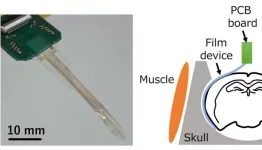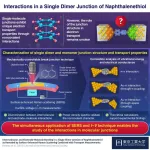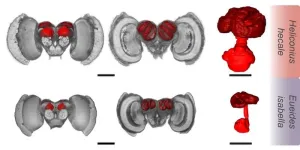(Press-News.org)
Defying conventional wisdom, researchers have uncovered a novel coupling mechanism involving leaky mode, previously has been considered unsuitable for high-density integration in photonic circuits. This unexpected finding opens new possibilities for dense photonic integration, revolutionizing the scalability and application of photonic chips in optical computing, quantum communication, light detection and ranging (LiDAR), optical metrology, and biochemical sensing.
In a recent Light Science & Application publication, Sangsik Kim, associate professor of electrical engineering at Korea Advanced Institute of Science and Technology (KAIST), and his students at Texas Tech University demonstrated that an anisotropic leaky wave can achieve zero crosstalk between closely spaced identical waveguides using subwavelength grating (SWG) metamaterials. This counter-intuitive discovery drastically increases the coupling length of transverse-magnetic (TM) mode, which has historically posed challenges due to its low confinement.
This research builds upon their prior studies of SWG metamaterials for reducing optical crosstalk, including control of evanescent wave's skin-depth [Nat Commun 9, 1893 (2018)] and exceptional coupling in anisotropic guided mode [Optica 7, 881-887 (2020)]. SWGs have recently made significant advances in photonics, enabling various high performance PIC components. However, integration density challenges remained for the TM mode, which exhibits approximately 100 times larger crosstalk than the transverse-electric (TE) mode, hindering high-density chip integration.
“Our group has been exploring SWGs for dense photonic integration, achieving significant improvements. However, previous approaches were limited to TE polarization only. In a photonic chip, there is another orthogonal polarization TM, which can double the chip capacity and is sometimes more desired than TE, such as in evanescent-field sensing. TM is more difficult to integrate densely than TE because it is typically less confined with a low width-to-height waveguide aspect ratio,” Kim explained.
Initially, the team believed it was impossible to reduce crosstalk using SWGs, as they expected leaky mode to enhance coupling between waveguides. However, they focused on the potentials of anisotropic perturbation with leaky mode, hypothesizing that cross-cancellation might be achievable.
Applying coupled-mode analysis to the modal properties of leaky SWG modes, they uncovered unique anisotropic perturbation with leaky-like mode, resulting in zero crosstalk between closely spaced identical SWG waveguides. Utilizing Floquet boundary simulations, they designed practically implementable SWG waveguides on a standard silicon-on-insulator (SOI) platform that is readily available in the industry, demonstrating remarkable crosstalk suppression and increased coupling lengths by over two orders of magnitude compared to strip waveguides.
This breakthrough also significantly reduces noise levels within PICs, with potential impacts on quantum communication and computing, optical metrology, and biochemical sensing. The researchers further emphasized the broader implications of their work, noting that this novel coupling mechanism could be extended to other integrated photonics platforms and wavelength regimes across visible, mid-infrared, and terahertz beyond the telecommunication band.
This surprising coupling mechanism has expanded the potential for dense photonic integration, defying conventional wisdom and pushing the field’s boundaries. As research continues, the photonics industry will likely see a shift towards denser, lower-noise, and more efficient PIC technologies.
END
A study examining unemployment and underemployment figures and suicide rates in Australia has found both were significant drivers of suicide mortality between 2004-2016.
The researchers say the findings indicate that economic policies such as a Job Guarantee, which prioritise full employment, should be a core part of any comprehensive national suicide prevention strategy.
Predictive modelling also revealed an estimated 9.5 percent of suicides reported during that time resulted directly from unemployment ...
Overview
Associate Professor Hiroto Sekiguchi (Department of Electrical and Electronic Information Engineering, Toyohashi University of Technology) and Assistant Professor Susumu Setogawa and Associate Professor Noriaki Ohkawa (Comprehensive Research Facilities for Advanced Medical Science, Dokkyo Medical University; Assistant Professor Setogawa is currently a Specially Appointed Assistant Professor at University Public Corporation Osaka) have developed a flexible electrocorticography (Note 1) film for simultaneous detection of multisensory information (Note 2) from multiple regions of the cerebral cortex by placing neural ...
Mycelium, an incredible network of fungal strands that can thrive on organic waste and in darkness, could be a basis for sustainable fireproofing. RMIT researchers are chemically manipulating its composition to harness its fire-retardant properties.
Associate Professor Tien Huynh, an expert in biotechnology and mycology, said they’ve shown that mycelium can be grown from renewable organic waste.
“Fungi are usually found in a composite form mixed with residual feed material, but we found a way to grow pure mycelium sheets that can be layered and engineered into different uses – from flat panels for the building industry to a leather-like material for ...
The structure of a molecular junction with noncovalent interaction plays a key role in electron transport, reveals a recent study conducted by researchers at Tokyo Tech. Through simultaneous surface-enhanced Raman scattering and current–voltage measurements, they found that a single dimer junction of naphthalenethiol molecule shows three different bondings, namely π–π intermolecular and through-π and through-space molecule–electrode interactions.
The π–π interaction is a type of noncovalent interaction that occurs when the electron clouds in the π orbitals ...
New research suggests that targeting autoimmune inflammation associated with amyotrophic lateral sclerosis (ALS) using two drugs, one of them already approved for multiple sclerosis, could be a promising approach for treatment.
ALS, also known as Lou Gehrig's disease, is a progressive neurodegenerative disease that affects the nerve cells in the brain and spinal cord. It leads to the gradual loss of muscle control, eventually resulting in paralysis and difficulty with speech, swallowing, and breathing. The exact cause of ALS is not fully understood, and currently, there is no cure ...
Taylor & Francis has taken a significant step in reducing unnecessary plastic use with the introduction of paperwrap for journal print copies mailed in the UK.
Paperwrap, a relatively new packaging technology, has become more common in recent years, but is typically most suited to publications with very high print runs. Taylor & Francis’ Global Supplier Team spent several months investigating how it might be applied to journal print runs, which included rolling out live trial mailings to colleagues around the world to test how the journals could be packaged, and whether there was any impact on the speed ...
A new talking therapy for depression has shown encouraging early signs of being more effective and cheaper to deliver than the current best practice of Cognitive Behavioural Therapy (CBT).
A pilot trial from the University of Exeter, funded by the National Institute of Health and Care Research (NIHR) and published in Lancet EClinical Medicine, has found Augmented Depression Therapy (ADepT) could be a significant advance in depression care.
A core feature of depression is anhedonia (reduced ...
A team of scientists led by CABI have conducted a new study which shows that three ways to fight the invasive Prosopis juliflora tree in Ethiopia, Kenya and Tanzania all proved very effective in almost all cases.
The three-year research, published in the journal CABI Agriculture and Bioscience, revealed that cut stump and basal bark herbicide application and manual uprooting were highly effective, killing the trees in between 85-100% of cases.
In addition, three incremental restoration interventions were tested ...
Laptops and schoolwork on kitchen tables, a deserted playground, face masks on a washing line, an empty church, a walk in the woods.
As the UK Covid inquiry continues for a fifth week, researchers at the University of East Anglia have created a unique snapshot of lockdown life.
When the pandemic first hit, the team embarked on a project to track the physical and mental health of the nation. More than a thousand participants signed up and up and they were followed every day for three months in the first study of its kind.
As well as keeping daily lifestyle diaries about their physical activity, diet and mood, ...
Heliconius butterflies’ brains grew as they adopted a novel foraging behaviour, scientists at the University of Bristol have found.
A region of their brain, known as the mushroom body due to its shape, are two to four times larger than those of their close relatives.
The findings, published today in Nature Communications, suggest that the structure and function of the nervous system are closely linked to an organism's ecological niche and behaviour.
Dr Stephen Montgomery of Bristol’s School of Biological Sciences explained: “Heliconius are the only butterflies known to collect and digest pollen, which gives them an adult source ...






